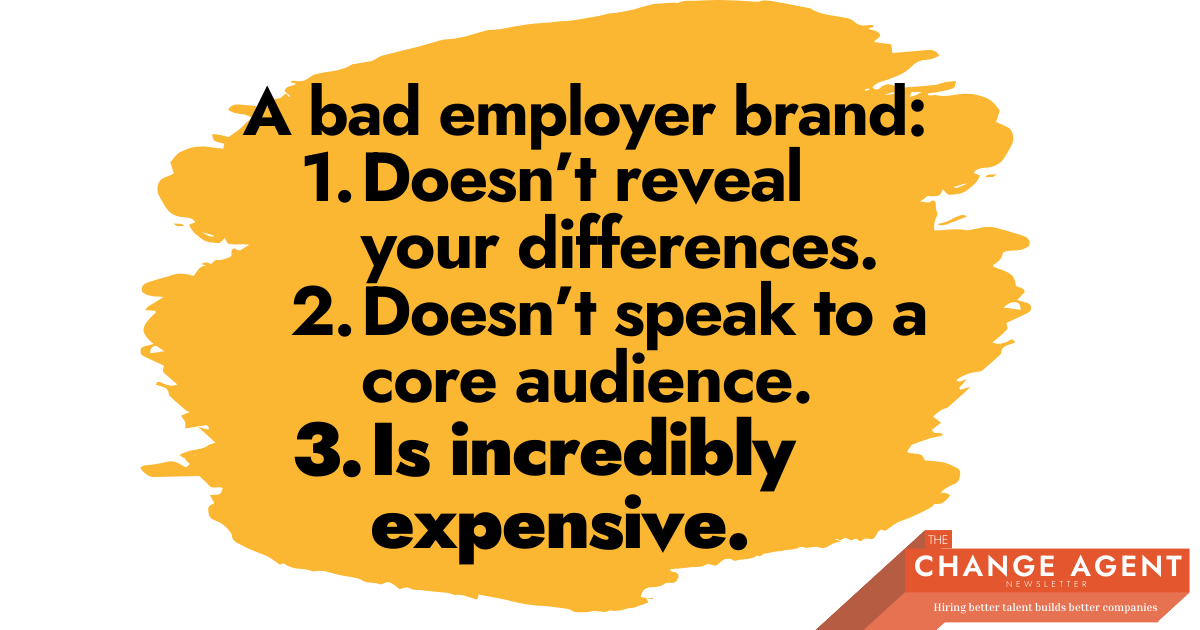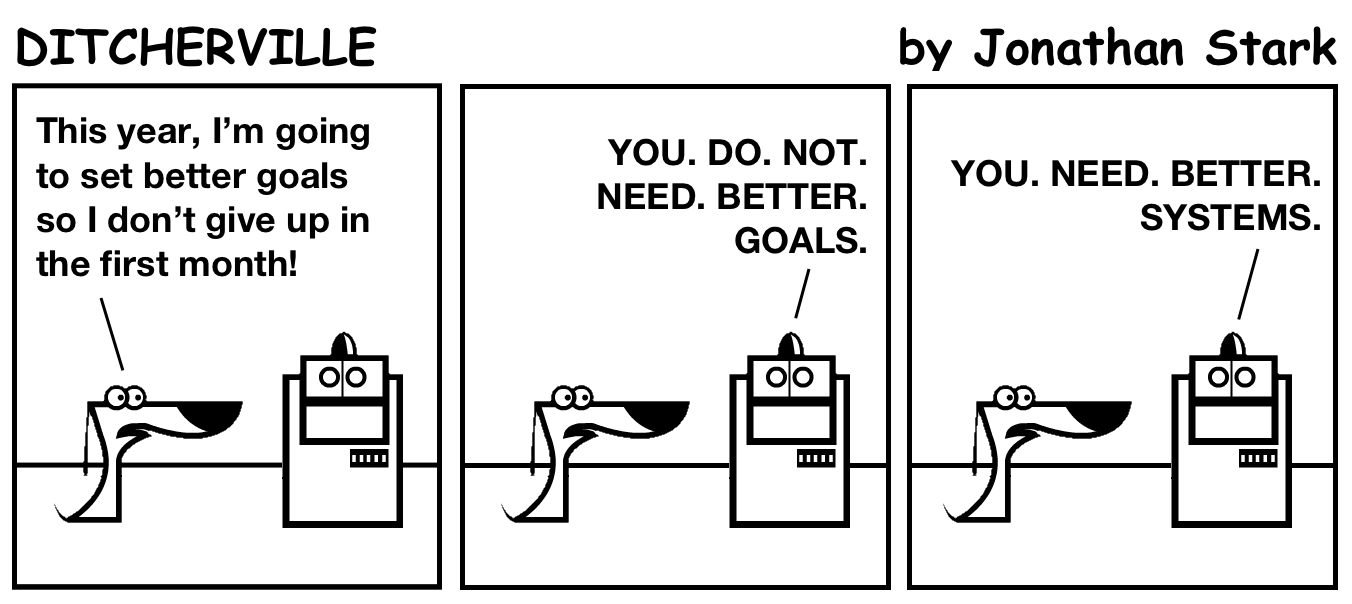The Cost of a Bad Employer Brand
We talk a lot about the cost and price tag of employer brand work, but we rarely look at the opportunity cost of NOT investing well in an employer brand. Once leadership understands the cost of an unsupported or phoned-in employer brand, the conversation about pricing and costs will shift in our favor.
But brands are inherently abstract things, so we need to start by defining what a “bad brand” looks like.
ONE: A bad brand doesn’t create or highlight differentiation. Talent acquisition is rife with examples of boringly pleasant brands and taglines that could be applied equally to hundreds of thousands of other companies. So, if it doesn’t help someone choose their future employer, what good is the brand?
TWO: A bad brand is designed to appeal to mass audiences. No company, no matter how big, needs to appeal to more than 1% of the talent pool. But bad brands are focused on saying “nice” things and hiding anything that might cause someone to balk, even if that person is someone you would never want to hire.
THREE: A bad brand doesn’t align with how staff see the company. Whether it is overly rosy, overly aspirational, or just a flat-out spin job, a bad employer brand seems to have no relation to the reality that current employees see and feel every single day. This is less about being trendily “authentic” and more about avoiding a sense of “bait and switch” where future employees never actually get the value they were promised.
So what causes bad branding?
In employer branding, there are two main sources of bad branding.
Brand “buyers” see platitudes as a win. Human Resources (and often Talent Acquisition) leadership assumes recruiting is just telling lots of people how “great” the company is. They rarely think about how the company positions itself will lead to appealing to one audience and pushing away another. They are very comfortable accepting blandly positive ideas as their new brand because they don’t think of branding as “creating differentiation.”
Leadership forces the brand to be overly positive. Leaders are beset by so much pushback, competition, and bad news in the marketplace, they often see the employer brand as the place where they can double down on how great the company is. As such, they push emerging employer brands that tell a complete story into those that read like glossy press releases.
So what are the costs of building and launching a bad brand?
Development costs
When calculating the cost of an ineffectual employer brand, we have to start with the cost of development. For most companies, that number starts at mid-five figures, but when you add in the time of stakeholders and TA staff, materials developed (add up the costs of all those videos!), and the opportunity costs from the project, for many companies six figures is a safe bet.
The problem with a bad brand is that in the process of development, it often feels like everything is aligned. An overly positive brand makes people feel good, like a sugar high. It’s hard to object to saying more positives. The real danger becomes clear upon launch when the brand doesn’t create differentiation, and the sugar hangover hits.
Suddenly, what looked like a home run became a swing and a miss.
Cost of lost candidates
A good brand makes it crystal clear to candidates why they should engage. They understand the value you are proposing to give them (hence, employer value proposition) and have decided that the value is worth their attention and time.
You might assume a bad brand that does not make that differentiated value clear won’t attract candidates, and that’s only partially true. A brand that can’t stop telling people how great it is will attract people who think that’s all a company needs to be. The “all good news all the time” brand won’t attract great talent and make the process of finding the best talent from available sources much harder.
The ATS will overflow with middling talent, overwhelming recruiters and hiring managers and making their task of selecting great options exponentially harder: when you make the haystack bigger but without adding needles, it becomes harder to find them.
Cost of frayed relationships with marketing and TA (and HMs)
A strong employer brand is like the vows in the marriage of marketing and recruiting, allowing both sides to better understand the other and work together to create a compelling and valuable recruiting message that serves everyone.
But because a bad brand doesn’t solve problems, it brings the two parties together in name only. There is no shared understanding, objective, or process, so the two sides continue to work in their usual manner, but with new lingering resentment based on the assumption that it was the other party who didn’t hold up their end of the marriage contract.
Loss of trust with recruiters
An employer brand is a burden on recruiters. It asks them to change their established processes with the promise of higher quality candidates and more engagement with talent.
The cost of implementing a bad brand means the recruiter does all the work for no return (or worse). Having gone through a bad brand process, the likelihood that they will be willing to following the next change initiative drops significantly, leaving you with a recruiting team that won’t change with the times.
Higher reliance on ads and agencies
One of the biggest driving factors in an employer brand is the anticipated cost savings from having to run fewer ads, rely on agencies less, and have more candidates accept offers. In the deck your employer brand partner used to sell leadership, there was at least one slide that calculated the anticipated savings year over year once the brand was in place.
But a bad brand doesn’t say anything compelling, so you’ll need to make up the shortfall in unrealized candidates through transactional spending on ads and agencies. And these expenses are significant.
Increasing attrition
A strong brand creates a kind of gravitational pull, keeping employees who, having seen the brand idea, and seen it proven out day in and day out, are less inclined to talk to recruiters and hear other companies’ pitches. That regular proof is like a vaccine against other recruiters’ vague rosy claims.
But a bad brand doesn’t do that. It muddies the water, making it not just unclear why people should join, but why they should stay.
Ironically, a bad brand tells employees that no one is saying much of value, so jumping ship for inexact claims and promises of higher rewards makes a lot of sense and people leave.
Lost top talent
This is the largest (but hardest-to-calculate) cost.
Somewhere out there are a handful of people who will act like gasoline poured on the flame of your business. They bring innovative approaches to product, development, sales and operations that will give your company what they need to put distance between them and the rest of the industry.
These talents aren’t diamonds in the rough. They are talented people who know their value, and thus have choices about where they will work.
A bad brand pushes them away because it isn’t helping them make a decision about your company. It doesn’t give a complete picture of what it's like to work there. Consequently, these catalysts will choose the companies that make that offering clear.
You’ll never know that they looked at or even considered your company, but your company will continue to attract the same mid-level talent that your hiring managers will swallow while wondering why they can’t interview great folks.
The cost of an employer brand can be measured in lost time, lost money, lost trust, and lost opportunities. These are the kinds of costs that aren’t obvious but become clear drains on the company overall, making them the kinds of costs your company simply can’t afford to pay.
🧮 The difference between “purpose” and value proposition. »
🧮 5 steps to help you get promoted in 2024 »
🧮 Culture is a remix. »
(Not surprising: most publications and writers are doing year-end wrap-ups or have closed shop this week, so I expect the links section to get busier next week.)
🏛️ All 2,200+ articles from this newsletter are in a searchable archive. Go get ‘em!
What January 1 Means
For a lot of people, January 1 means a new start. A change to flush away the past in a flurry of holiday revelry, eating, drinking, and making merry while the calendar changes.
But it turns out, even if we change companies. change jobs, or change living arrangements, there are no clean starts. We enter each new year with all our old baggage. Our histories. Our biases. Our scars.
These things don’t go away just because of the date.
If we assume January 1 is a clean start, we ignore the baggage we’re bringing into the new year. Baggage we’ll be tripping over in the coming months.
So let’s not see January 1 as the day the tide wipes away the slate, but as the day we take a little time and clear things away ourselves.
And when you’re clearing projects and processes out, ask yourself the following questions:
What was the purpose of this?
Do I still need that purpose?
Are there other ways to achieve that?
What did I learn from trying this?
Knowing what I know now, what would I have done differently?
Is it time to stop this? (and what will that free me up to do in 2024?)
The most effective leaders are the ones who know that there is plenty of change heading people’s way that is out of our control, so focus on creating intentional change where they can.
NEW: Employer Brand Buyer’s Guide »
105 free (or almost free) ways to activate your brand »
Employer Brand Breakdown series »
Biotech Recruiting limited run email course »
Proof employer brand works »
Biotech Recruiting Chat series »
Employer Brand minute series »
The Brand Plan podcast »
The Talent Cast podcast »
On-demand video courses »
***This Newsletter Contains No ChatGPT***
-James Ellis [LinkedIn] [Website]
###










